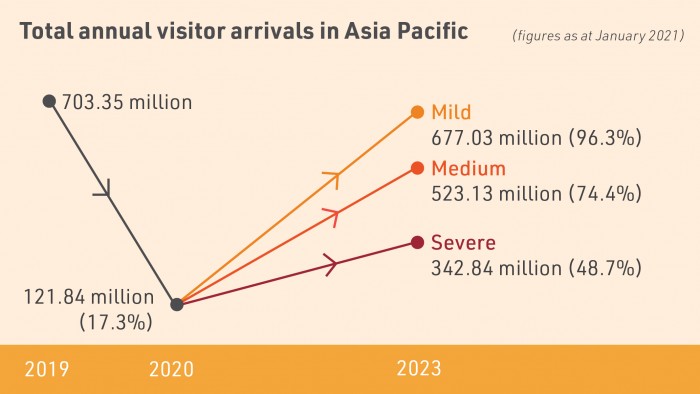Tourism demand forecast helps industry prepare for recovery
Other Articles
COVID-19 has caused the tourism industry worldwide to plunge to levels last seen 30 years ago. International tourist arrivals declined by an unprecedented 74% in 2020, with the loss of more than one billion tourists and US$1.3 trillion of income compared to 2019, according to the World Tourism Organization (UNWTO).
In Hong Kong, the number of tourist arrivals dropped by more than 90% year-on-year during the first three months of 2021, severely affecting the city’s economy and the livelihood of many families.

Professor Song Haiyan
The situation has caused many people in the industry to ask when and to what extent tourism will recover. The Pacific Asia Travel Association (PATA), in collaboration with PolyU’s School of Hotel and Tourism Management (SHTM), released the Asia Pacific Visitor Forecasts 2021-2023 earlier this year, which provided scientific forecasts for tourist numbers for 39 destinations in the Asia Pacific region. The study was co-authored by Professor Song Haiyan, Associate Dean and Chair Professor of SHTM and an expert in tourism demand modelling and forecasting, along with academics from the SHTM’s Tourism Forecasting Unit, Zhejiang University, University of Macau, University of Nottingham in Ningbo, and University of Surrey, UK.
According to this study, total annual visitor arrivals in Asia Pacific dropped to 121.84 million in 2020, the equivalent of just 17.3% of 2019’s total. Numbers are expected to recover from this low point to 96.3%, 74.4% or 48.7% of the 2019 level by 2023 under mild, medium and severe scenarios respectively. Island destinations in the Pacific are expected to have the highest recovery rate under all scenarios, as they can control the spread of the pandemic more easily, with visitors coming mainly from two countries, namely Australia and New Zealand.
In 2019, prior to the onset of the Covid-19 pandemic, the research team applied econometric and time series models to create the initial forecasts. To adjust for the impact of COVID-19, they then used data for the first two quarters of 2020 to rework the forecasts for the period from the third quarter of 2020 to the fourth quarter of 2023.
The three scenarios were developed taking into consideration the ongoing COVID-19 situation and the recovery of various economies. The researchers also looked at research on the effect of past pandemics (e.g. SARS and H1N1) on tourism, as well as assessments on the impact of COVID-19 on national economies and tourism by organisations such as Oxford Economics and UNWTO.
Presenting the forecasts in a webinar, Professor Song told the audience the figures would be adjusted as the situation evolved, and the effectiveness of vaccines became better known.
SHTM puts knowledge transfer high on its research agenda. This is the seventh report it co-produced with PATA. Professor Kaye Chon, Dean and Chair Professor of SHTM, believes that by accurately predicting tourist arrivals, the forecasting system will assist Asia Pacific destinations in formulating strategies to prepare for the recovery in the coming years.

By 2023, total annual visitor arrivals in Asia Pacific are expected to reach 96.3%, 74.4% or 48.7% of the 2019 level under mild, medium and severe scenarios respectively.






